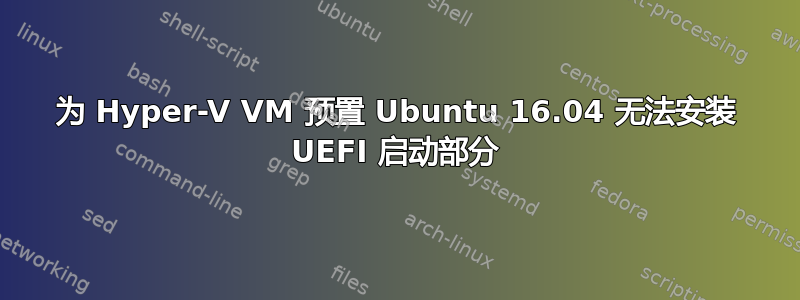
我正在使用 Hyper-V(在 Win10 和 Win2016 上)构建 Ubuntu 基础映像打包机。机器构建良好,我可以毫无问题地启动导出的虚拟机。但是,如果我使用新创建的虚拟硬盘创建新的虚拟机,它无法启动并显示一条消息
No x64-based UEFI boot loader was found
我从本·阿姆斯特朗的博客这与 UEFI 启动文件未写入磁盘的正确位置有关。
我已经更新了预置文件以生成 EFI 驱动器和启动驱动器,但是我不知道该向预置文件或启动命令添加什么内容,以便在 EFI / 启动驱动器中安装所需的文件,以便我可以将虚拟硬盘与 Gen 2 Hyper-V 虚拟机一起使用。
我的打包机配置如下:
{
"variables": {
"admin_username": "admin",
"admin_password": "admin",
"dir_deploy": null,
"dir_http_user": null,
"dir_scripts_user": null,
"dir_temp": null,
"iso_checksum": null,
"iso_url": null,
"vm_name": "not_really_a_vm_name",
"vm_ram_size_in_mb": "2048",
"vm_switch_name": "this_switch_does_not_exist",
"vm_switch_vlan": ""
},
"builders": [
{
"boot_wait": "5s",
"boot_command": [
"<esc><wait10><esc><esc><enter><wait>",
"set gfxpayload=1024x768<enter>",
"linux /install/vmlinuz ",
"preseed/url=http://${NetworkHostIpAddressForPreseed}:{{.HTTPPort}}/preseed.cfg ",
"debian-installer=en_US auto locale=en_US kbd-chooser/method=us ",
"hostname={{.Name}} ",
"fb=false debconf/frontend=noninteractive ",
"keyboard-configuration/modelcode=SKIP keyboard-configuration/layout=USA ",
"keyboard-configuration/variant=USA console-setup/ask_detect=false <enter>",
"initrd /install/initrd.gz<enter>",
"boot<enter>"
],
"communicator": "ssh",
"enable_secure_boot": false,
"generation": 2,
"guest_additions_mode": "disable",
"http_directory": "{{ user `dir_http_user` }}",
"iso_url": "{{user `iso_url`}}",
"iso_checksum_type": "sha256",
"iso_checksum": "{{user `iso_checksum`}}",
"iso_target_path": "{{ user `dir_temp` }}/packer",
"output_directory": "{{ user `dir_temp` }}/{{ user `vm_name` }}",
"ram_size": "{{user `vm_ram_size_in_mb`}}",
"shutdown_command": "echo '{{user `admin_password`}}' | sudo -S -E shutdown -P now",
"ssh_password": "{{user `admin_password`}}",
"ssh_timeout": "4h",
"ssh_username": "{{user `admin_username`}}",
"switch_name": "{{user `vm_switch_name`}}",
"type": "hyperv-iso",
"vm_name": "{{ user `vm_name` }}"
}
],
"provisioners": [
{
"type": "shell",
"execute_command": "echo '{{user `admin_password`}}' | sudo -S -E sh {{.Path}}",
"scripts": [
"{{ user `dir_scripts_user` }}/ubuntu/update.sh",
"{{ user `dir_scripts_user` }}/ubuntu/network.sh",
"{{ user `dir_scripts_user` }}/ubuntu/cleanup.sh",
"{{ user `dir_scripts_user` }}/ubuntu/sysprep.sh"
]
}
]
}
预置文件如下:
# preseed configuration file for Ubuntu.
# Based on: https://help.ubuntu.com/lts/installation-guide/armhf/apbs04.html
#
# *** Localization ***
#
# Originally from: https://help.ubuntu.com/lts/installation-guide/armhf/apbs04.html#preseed-l10n
#
d-i debian-installer/locale string en_US.utf8
d-i console-setup/ask_detect boolean false
d-i console-setup/layout string us
d-i kbd-chooser/method select American English
#
# *** Network configuration ***
#
# Originally from: https://help.ubuntu.com/lts/installation-guide/armhf/apbs04.html#preseed-network
#
d-i netcfg/choose_interface select auto
d-i netcfg/dhcp_failed note ignore
d-i netcfg/dhcp_options select Configure network manually
d-i netcfg/confirm_static boolean true
d-i netcfg/get_hostname string unassigned-hostname
d-i netcfg/get_domain string unassigned-domain
d-i netcfg/wireless_wep string
#
# *** Account setup ***
#
# Originally from: https://help.ubuntu.com/lts/installation-guide/armhf/apbs04.html#preseed-account
#
d-i passwd/user-fullname string admin
d-i passwd/username string admin
d-i passwd/user-password password password
d-i passwd/user-password-again password password
d-i user-setup/encrypt-home boolean false
d-i user-setup/allow-password-weak boolean true
d-i user-setup/encrypt-home boolean false
#
# *** Clock and time zone setup ***
#
# Originally from: https://help.ubuntu.com/lts/installation-guide/armhf/apbs04.html#preseed-time
#
d-i clock-setup/utc boolean true
d-i clock-setup/utc-auto boolean true
d-i time/zone string UTC
#
# *** Partitioning ***
#
# Originally from: https://help.ubuntu.com/lts/installation-guide/armhf/apbs04.html#preseed-partman
#
d-i partman/choose_partition select finish
d-i partman/confirm boolean true
d-i partman/confirm_nooverwrite boolean true
d-i partman-auto/method string lvm
d-i partman-auto/purge_lvm_from_device boolean true
d-i partman-lvm/device_remove_lvm boolean true
d-i partman-lvm/device_remove_lvm_span boolean true
d-i partman-lvm/confirm boolean true
d-i partman-lvm/confirm_nooverwrite boolean true
d-i partman-auto-lvm/guided_size string max
d-i partman-auto-lvm/new_vg_name string system
d-i partman-auto/choose_recipe select grub-efi-boot-root
d-i partman-partitioning/confirm_write_new_label boolean true
d-i partman/default_filesystem string ext4
d-i partman-auto/expert_recipe string \
grub-efi-boot-root :: \
1 1 1 free \
$bios_boot{ } \
method{ biosgrub } \
. \
256 256 256 fat32 \
$primary{ } \
method{ efi } \
format{ } \
. \
512 512 512 ext4 \
$primary{ } \
$bootable{ } \
method{ format } \
format{ } \
use_filesystem{ } \
filesystem{ ext4 } \
mountpoint{ /boot } \
. \
4096 4096 4096 linux-swap \
$lvmok{ } \
method{ swap } \
format{ } \
. \
10000 20000 -1 ext4 \
$lvmok{ } \
method{ format } \
format{ } \
use_filesystem{ } \
filesystem{ ext4 } \
mountpoint{ / } \
.
d-i partman-partitioning/no_bootable_gpt_biosgrub boolean false
d-i partman-partitioning/no_bootable_gpt_efi boolean false
# enforce usage of GPT - a must have to use EFI!
d-i partman-basicfilesystems/choose_label string gpt
d-i partman-basicfilesystems/default_label string gpt
d-i partman-partitioning/choose_label string gpt
d-i partman-partitioning/default_label string gpt
d-i partman/choose_label string gpt
d-i partman/default_label string gpt
# Keep that one set to true so we end up with a UEFI enabled
# system. If set to false, /var/lib/partman/uefi_ignore will be touched
d-i partman-efi/non_efi_system boolean true
#
# *** base system installation ***
#
# Originally from: https://help.ubuntu.com/lts/installation-guide/armhf/apbs04.html#preseed-apt
#
d-i base-installer/kernel/override-image string linux-server
#
# *** Package selection ***
#
# originally from: https://help.ubuntu.com/lts/installation-guide/armhf/apbs04.html#preseed-pkgsel
#
tasksel tasksel/first multiselect standard, ubuntu-server
# Minimum packages (see postinstall.sh). This includes the hyper-v tools
d-i pkgsel/include string openssh-server ntp linux-tools-$(uname -r) linux-cloud-tools-$(uname -r) linux-cloud-tools-common
d-i pkgsel/upgrade select none
d-i pkgsel/update-policy select none
d-i pkgsel/install-language-support boolean false
#
# Boot loader installation
#
d-i grub-installer/only_debian boolean true
d-i grub-installer/with_other_os boolean true
d-i grub-installer/bootdev string /dev/sda
# grub-install –target=x86_64-efi –efi-directory=/boot/efi –no-nvram –removable
#
# *** Preseed other packages ***
#
d-i debconf debconf/frontend select Noninteractive
d-i finish-install/reboot_in_progress note
choose-mirror-bin mirror/http/proxy string
答案1
设置d-i grub-installer/force-efi-extra-removable boolean true将把 Grub 安装为 EFI/boot/bootx64.efi,但是 Grub 未使用 Microsoft 密钥签名,因此如果您正在使用它,这将破坏安全启动。
另一种方法是使用这个,它复制安装在 EFI/ubuntu 中的 Shim + Grub 设置
d-i preseed/late_command string \
mkdir -p /target/boot/efi/EFI/BOOT && \
cp /target/boot/efi/EFI/ubuntu/* /target/boot/efi/EFI/BOOT && \
cd /target/boot/efi/EFI/BOOT/ && mv shimx64.efi BOOTX64.EFI
编辑:请注意,这/target是目标系统的文件系统所以这个路径不应该出现在预置文件的磁盘部分。
答案2
通过在预置文件中添加以下行,使 GRUB 在efi分区上安装 UEFI 引导程序
d-i grub-installer/force-efi-extra-removable boolean true
添加该行后,UEFI 引导程序最终会进入虚拟硬盘驱动器,这意味着可以独立于虚拟机配置重复使用该驱动器。


